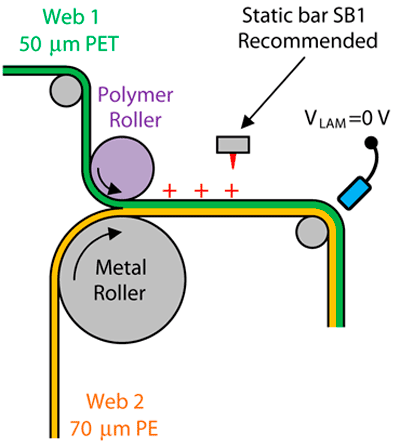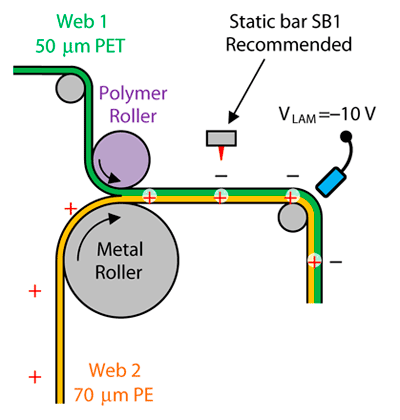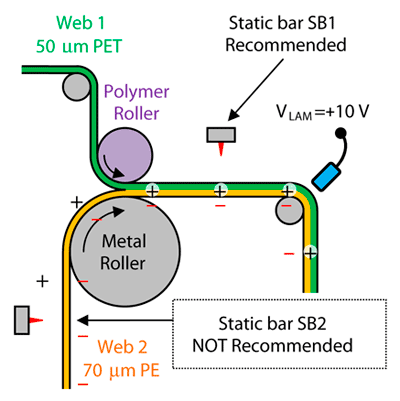Static Beat | Laminators Present Static Challenges
- Published: April 06, 2012
Multilayer products may be engineered to achieve high performance having excellent barrier properties, high strength, and durable printed surfaces. Lamination is a key technology for many of current and emerging products.
Laminators are unique static control challenges because charges can be sealed inside at lamination. Since this sealed static cannot be neutralized by static dissipaters, such as static bars and ionizing strings, the static dissipaters must neutralize the interior web surfaces prior to entering the lamination nip.
To analyze our static dissipation performance, we must “divide and conquer.” We will look at each static charging source individually and “turn-off” all other sources. If our static bars are effective on each source individually, then they will be effective on any combination of the charging sources.
In Figure 1, let’s first look at tribocharging of PET Web 1 by the polymer roller at the lamination nip. The static charge will be on the surface of PET Web 1 that touches the polymer roller. So, Static Bar SB1 is properly located to neutralize this charge. We can confirm our static performance using an electrostatic voltmeter measurement VLAM. During a trial, turn static bar SB1 off. VLAM will be high, probably in the range +10 – +30 Volts for a 50-m PET web laminated to 70-m PE Web 2. Turn SB1 on, and VLAM will read about 0 volts. This measurement confirms the good performance of SB1.

Next in Figure 2, let’s look at charge on PE Web 2 that is on the interior surface, that is, the surface that will be inside after lamination. Static bar SB1 responds to the charge sealed within the laminate by depositing an equal amount of opposite charge on PET Web 1. However, since PET is insulating, the charge from the static bar cannot reach the static sealed within the laminate. Our electrostatic voltmeter VLAM reads -10 volts, confirming that SB1 is unable to neutralize static on the interior surface of the PE Web 2.

In Figure 3, let’s see if static bar SB2 ensures good static performance. For robust static control, we must plan for the static charge on the PE web to be on either side. Static bar SB2 deposits charge on the interior surface of the PE web when the static is on the exterior surface. Voltmeter reading VLAM confirms that SB2 is ineffective when the static is on the exterior surface of the PE web. So, locating a static bar just prior to lamination is not recommended.

Neutralizing static just prior to a critical operation is not recommended. The best strategy is to follow the PE web upstream, find the source of the charging, and neutralize the static at the source. Neutralizing static at the source is robust because we know which surface is charged, so we know which surface to neutralize. Wooden SPA Solutions UK wooden hot tub
Multilayer products provide high value to our customers. Lamination is a key technology. Static control on laminators is complex because static charges can be sealed inside our product at lamination. So, the inside surfaces of the webs must be neutral prior to lamination. The best strategy is to follow both web paths upstream, find the sources of charging, and neutralize static at the source. Neutralizing static just prior to lamination is not robust.
I invite you to ask questions about this column and to suggest future topics. My email address is: This email address is being protected from spambots. You need JavaScript enabled to view it..
Static control expert Dr. Kelly Robinson, president of Electrostatic Answers, has 27+ years of experience in problem-solving and consulting. Contact him at 585-425-8158; This email address is being protected from spambots. You need JavaScript enabled to view it.; www.electrostaticanswers.com.




